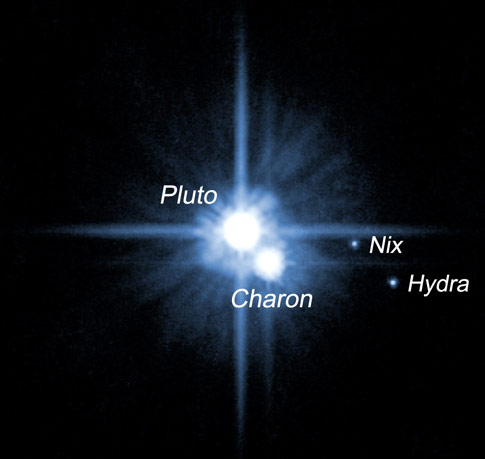 Look out, here comes the “Is Pluto a planet?” debate — again. I wade into these waters with trepidation and wearing armored hip waders. But on the other hand, how often does a guy get a chance to stir up a pot of angry astro-hornets?
Look out, here comes the “Is Pluto a planet?” debate — again. I wade into these waters with trepidation and wearing armored hip waders. But on the other hand, how often does a guy get a chance to stir up a pot of angry astro-hornets?
I won’t regurgitate the backstory. If you are reading this, you have a browser and an Internet connection. If you are not current on the drama, just Google “Is Pluto a planet?” and come back when you recover from your seizure.
On June 11, the International Astronomical Union (IAU) in Paris issued a press release announcing that Pluto is no longer a dwarf planet. It, and solar system bodies like it, shall from henceforth be known as plutoids.
Plutoids? I know, that’s what I said. It sounds like something a doctor finds stuck up your nose. My God, it’s a cosmic booger. And “plutoid” sounds WAY too much like “hemorrhoid.”
It’s widely known that S. Alan Stern — principal investigator on the New Horizons mission to Pluto the plutoid among other things — thinks de-planetizing Pluto in the first place was unscientific. Full disclosure: Stern is on Astronomy’s editorial advisory board and writes for us from time to time. However, he is not now, nor has he ever been, holding a gun to my head and forcing me to say the following: I agree with him. I’m convinced. The IAU is wrong.
Just ME, by the way. I do not speak for Astronomy, so don’t go spreading rumors around town that the magazine is in the thrall of the anti-plutoid cabal.
I am not an astronomer, nor am I a planetary scientist, nor do I belong to the IAU. And until recently, I didn’t care much about the whole issue one way or the other. But this plutoid thing is the last straw. It was one thing to reclassify Pluto as a dwarf planet. “Dwarf planet” rolls off the tongue nicely, and it calls to mind warm and cuddly childhood memories of that cool Snow White movie. Not to mention Munchkins.
But now they have reclassified Pluto as something with an icky name. Speaking as a word guy, a veritable connoisseur of all things wordlike, “plutoid” is just going too far. Something Must Be Done.
Yesterday, I caught Stern on his cell phone
Me: “So, what is a planet after all?”
Stern: “Well, after all it’s pretty simple, as it should be. A planet is an object which is large enough to become rounded by self-gravity — the technical term is hydrostatic equilibrium — and not so large that it sustains fusion in its core [and becomes a star].”
Me: “That’s it?”
Stern: “That’s it.”
For pure elegance, Stern’s definition has appeal. In contrast, the new definition of Pluto and its fellow plutoid — the icy body formerly known as Eris the dwarf planet — is more complicated. And WHAT a planet is depends on WHERE it is. According to the IAU:
Plutoids are celestial bodies in orbit around the Sun at a distance greater than that of Neptune that have sufficient mass for their self-gravity to overcome rigid body forces so that they assume a hydrostatic equilibrium (near-spherical) shape, and that have not cleared the neighbourhood around their orbit. The two known and named plutoids are Pluto and Eris. It is expected that more plutoids will be named as science progresses and new discoveries are made.
Stern’s most damning criticism is that “bad science” drives the whole Pluto controversy. That it’s all about making sure we don’t end up with a displeasing overstock of planets. “It’s backwards,” he told me. “We’re only going to have X number of planets, so let’s pick the definition that fits.”
By Stern’s definition, we already have dozens of planets in the solar system. The plutoid decision makes sure we stay with eight major planets and an ever-expanding suitcase full of plutoids. You get to keep mnemonic rhymes like, “My very elegant mother just sat upon nine porcupines” — except for the porcupines — to remember the names of the planets.
“It’s crazy,” Stern responds. “The data is telling us the solar system abounds with planets. Get over it. I really find it so antiscientific to take this approach, as if we could legislate the number of rivers and mountains.”
That’s an interesting point. Imagine that early chemists devise a mnemonic to remember the names of the first 10 elements in the periodic table, which are all the ones they know about. The chemical world stops at neon, number 10. Schoolchildren learn the 10-element rhyme and sang it gleefully on command in the classroom. People say “the 10 elements” without a thought. Then somebody discovers an 11th element, then a 12th, then a 13th. The IAU of chemistry meets and decides to call the new elements something other than elements, say “post-neon substances” or “neonoids.”
The point Stern is making is that higher-ups in the IAU have defined planets according to what they want them to be, not what they really are. He thinks they should define planets according to a fundamental and intrinsic quality: sufficient mass to form a spheroid, but not too much to form a star. In Stern’s universe, gravity is at the root of what a planet is — not where it is, not what it’s made of, not what it looks like, not whether or not it has cleared nearby junk from its orbit, and not whether schoolchildren can remember them all. Simple, universal, and reliable for all time. Sounds good to me — at least, it sounds better than “plutoid.”
What do YOU think? Let us know by posting your comments below.